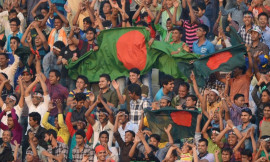
This decades-old, self-flattering format of a Pakistan Day supplement brazenly betrayed the extreme poverty of vision within our bureaucracy and a totally absent understanding of modern-day marketing techniques and communication strategies. This medieval full-page advertisement also reflected the official ignorance of the need for a credible and attractive governmental narrative — at least for foreign readers.
One can only sympathise with those who put together the supplement — wasting hundreds of millions on similar editions in various capitals. With apologies to many brilliant officers in the ministries of foreign affairs and information, one is pained to say that most of them seem totally oblivious to what Pakistan needs at the moment.
Instead of putting up iconic figures with cross-border repute and trans-national appeal like Shahid Afridi (who has galvanised the Bengali youth like nobody else and enjoys a roaring image in the context of ongoing Twenty20 competition) or illustrations of Pakistan’s legal luminaries, of the vibrant electronic media, a recap of the budding fashion industry in Karachi and Lahore or Rahat Fateh Ali Khan, or something on how Pakistan has created space for women at the national and provincial levels, we have images of our unpopular current leaders. Even a box item on Hum TV and the “Humsafar” soap, which excited many in India and Bangladesh, would have done. Or the image of Shere Bengal Fazle Haq or Hussain Shaheed Suharwardy could also have served as a bridging factor. Communication means marketing something that has relevance to the local context, something to which the locals can relate. But in our case, this element is missing. It may have been okay to reproduce Jinnah’s ideals for Pakistan, but what glorious services have the Mamnoon or the Sharifs rendered which foreign readers could relish?
This side of the Pakistani narrative, i.e., the ruling elite adorning the front and back pages of newspapers at the cost of precious public money, or addressing their own people via state and private TV, saying things and making claims that would not be remotely close to their actual deeds, is just disappointing.
Why couldn’t our bureaucrats flag the recently adopted National Internal Security Policy (NISP), which, despite its flaws, still makes many Pakistanis proud that the country has, at least for the first time after a decade of violence, a framework to fight terrorism.
For years, Pakistan got a lot of flak from the national and foreign media for not having a strategy and that is why the NISP must be touted as a big step forward.
Here in Dhaka — the capital of a country often swept by natural calamities and political turmoil — the first counter-terror strategy was presented last year. Here, the minister of finance is vowing to take the country’s exports to $75 billion in five years. In Islamabad, it appears, confusion surrounds, stymied by opportunism, lack of vision and ignorance of the imperatives of credible and long-lasting communication and development strategies. Why does one feel disgusted about the Pakistan Day supplements abroad? Simply because people abroad wonder whether Pakistan is consciously undertaking steps to fight terrorism and counter radicalisation?
At a consultation with Bangladeshi friends, participants wondered whether indiscriminate rule of law is being turned into a priority area of intervention. Bangladeshi officials from the foreign and home ministries made impressive presentations on their counter-terror and counter-radicalisation initiatives, most of which revolved around strict and indiscriminate enforcement of law.
Published in The Express Tribune, March 26th, 2014.
Like Opinion & Editorial on Facebook, follow @ETOpEd on Twitter to receive all updates on all our daily pieces.
COMMENTS (5)
Comments are moderated and generally will be posted if they are on-topic and not abusive.
For more information, please see our Comments FAQ












































Also one more observation - about the Lahore declaration - in the Dhaka national museum - special emphasis was placed on the word 'states' - saying that at the time of Independence, this aspect was forgotten and one country was formed.
Other than the Ahsan Manzil in Puran dhaka where the Muslim league was formed in 1906 - there is very little commemoration of 1947. A mention is made in the national museum. Otherwise it is all about 1947-71 and the language battle. The poster of Yahya Khan caricatured as a monstrous gorilla is ubiquitous. I agree with the author - Pakistan needs to build bridges with images of Shere Bengal Fazle Haq or Hussain Shaheed Suharwardy.
The author has apologized to the brilliant officers in the Ministry of Foreign Affairs and Information. Are they really brilliant? The Pakistan Day supplement says it all.
Government jobs in Pakistan are offered on a quota system with bulk of the openings going to Punjab. Then we hear the political and bureaucratic rant that the positions are filled on the basis of merit. Yes. merit within the assigned job quota for provinces as opposed to OPEN MERIT.
How is the Indian civil service filled? It is on the basis of complete Open Meriit?
As you sow, so shall you reap! The system needs to be fixed.
Absolutely correct. It's a mirror for our " Babus " in the government. They haven't changed in 66 years & are unlikely to change in future. Of course they can change if we elect educated & enlightened politicians above them. With the current crop of politicians like Dastis, Jatois, Chaudhrys, etc I can guarantee you a worst scenario. Allah...pity on us.
I remember during the floods in Pakistan, Times Square NY made a great charitable gesture and let a free video campaign run on the giant screens on the square asking for charity for Pakistan floods. What was put up by the Pakistan embassy instead was photos of the PM, President and the Ambassador and their meaningless slogans on the screens!!